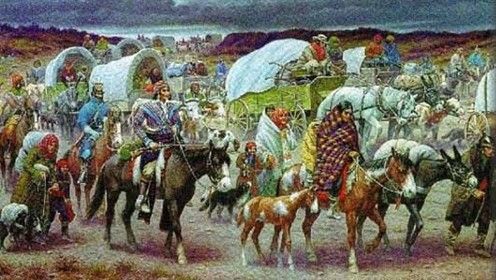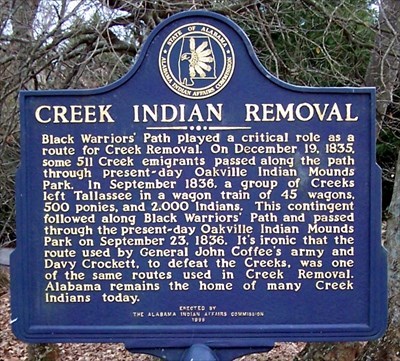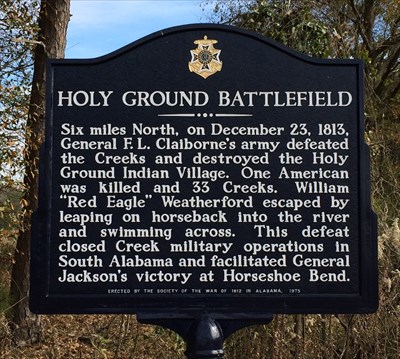The Creek Indian Removal Played the Major Role in The History of Alabama
The Creek Indian Removal played a very important role in the history of Alabama, and most of it is not good.
When you objectively look back at the entire history that led to what would become known as the “Trail of Tears”, both sides played major roles.
However, even with the Treaty of Cusseta, which was signed in 1832, the removal would still happen, and in all, 125,000 Native Americans were removed from the south.
 The Creek Indian Removal
The Creek Indian RemovalOf those 125,000, 15,000 where from the Creek tribe in what today is known as Alabama, and over 3,500 died before they reached their new “homes”
Today, the only remaining members of this pride and powerful tribe are the Poarch Creeks, located in Escambia County, which is the only recognized Creek lands left in the state.
The History of the Creek Indian Removal
 The Creek Indian Removal Historical Marker
The Creek Indian Removal Historical MarkerThe history of the Creek Indian Removal starts with the five powerful tribes that resided in the Southeast, which were later called the “Five Civilized Tribes”
The tribes included in this group were the Creek, the Chickasaws, the Seminole, the Choctaw, and the Cherokee.
The Creek Nation at one time was one of the largest and most powerful tribes in the entire southeast.
In the early 1700’s, the Seminole tribe was considered part of the Creek nation, which made it even stronger and more dangerous to other tribes in the area.
However, in the late 1700’s the Seminole nation split with the Creek nation and would settle in what would become known as Spanish Florida.
Together, they controlled literally millions of acres in what is today known as Alabama, Georgia, and Florida.
However, after the American Revolution, most of their land was either lost or stolen, depending on how you take history, through a series of land treaties.
What most historians do not tell you is that large parts of these vast lands were taken by theft from squatters, or arrangements that were made but never fully honored.
By the year 1836, literally all of the Creek Nation had either left their homelands that they had lived on for centuries voluntarily, or they were forced to move.
However, the true history of the Creek Indian Removal starts in the year 1825.
In 1825, William McIntosh, who was a Coweta headman or Chief of some of the Creek Towns, signed the Treaty of Indian Springs.
This treaty immediately ceded all of the Creek land in Georgia as well as huge tracts of land in Alabama, to the Federal Government.
However, there was one small problem with this act; the vast majority of the Creek Nation opposed this treaty.
The main reason for their opposition is that they were never consulted, nor did McIntosh have the approval of the Creek National Council.
Under Creek law at the time, any type of treaty without their approval was punishable by death.
The Creek Nation took its own laws very seriously, and in May of 1825, William McIntosh was executed by his peers.
Shortly after his execution, a delegation of Creeks traveled to Washington D.C., to nullify a treaty they viewed as “illegal” under their laws.
In January of 1826 it was nullified, and the Creek leaders that had traveled to Washington, signed the Treaty of Washington.
This treaty allowed to Creek nation to keep the land in Alabama, but not the land in Georgia.
However, there were factions of the Creek Nation that abided by the Treaty of Indian Springs, as they supported what McIntosh had signed.
In the late part of 1827, over 700 Creek men, women, and children, as well as over 80 slaves owned by McIntosh, started their travels to Oklahoma to honor this original treaty.
There would be more volunteers that would immigrate to Oklahoma, and by 1829 over 1600 Creeks had left Alabama to be relocated there.
While most of these Creek that relocated to Oklahoma were followers of McIntosh, some were from the Georgia Creek Lands, which had been ceded over to the government.
However, what history does not fully teach everyone during the Creek Indian Removal is that a large number of the Creeks that voluntarily went to Oklahoma did so for their safety.
They felt threatened by the white settlers that had illegally squatted on their land they kept by the Treaty of Washington and did not want to battle anymore.
This eventually led to the Treaty of Cusseta, which was signed on March 24, 1832, which lasted for about four years before the Creek War of 1836 ensued.
The Treaty of Cusseta
The Treaty of Cusseta would eventually become the final straw for the Creek Indian Removal, but the question is who was really at fault.
By the time of the Treaty of Cusseta, the territory the Creeks now lived on was reduced to a large strip of land.
 Chief William McIntosh
Chief William McIntoshThis strip of land was located in what today is east-central Alabama and ran along the current border with Georgia.
The Indian Removal Act of 1830 had already been signed by President Andrew Jackson, but the previous Treaty with the Creeks was supposedly still honored.
However, the biggest stipulation in this treaty was the prohibition of white settlers on these Creek lands.
This did not stop white settlers from moving into this territory, which was causing a tremendous amount of tension in the Creek Nation.
The white settlers were hunting on Creek land and killing off their food supply, which led to Creek warriors attacking the town of Roanoke, Georgia.
The Treaty of Cusseta was the result of this attack, and now the Creek Nation had to abide by this new treaty.
This new treaty required that the Creek nation cede all land east of the Mississippi River, including the land they held in Alabama.
In turn, individual Creeks would be given land claims in their former territories, and each of the 90 Creek Chiefs would divide up this land.
However, despite these land grants, it was very clear that the Federal government wanted to Creek Indian Removal to happen as quickly as possible.
They agreed to pay expenses for all Creek emigrants for the first year after their relocation, as well as other promises.
These promises included $350,000 to be paid to the Creeks, as well as 20 square acres of land to be sold to support Creek children who had no parents.
The Creek nation was again taken advantage of, as they had no idea of land values, and sold some off this land to settlers for a fraction of what it was worth.
Those Creeks that did not sell where quickly overran and overwhelmed by an onslaught of white settlers, and if they tried to resist, were attacked by local militia.
This reached a boiling point in 1836, when war broke out again between the Creeks and the settlers, which led to the final stages of the Creek Indian Removal.
This war was called the Second Creek War, when the Creek warriors who had had enough, attacked the current counties of Chambers, Macon, Pike, Lee, Russell, and Barbour, all in Alabama.
This new war allowed President Andrew Jackson to finish the Creek Indian Removal, once the Creek warriors were captured.
He ordered the United States Calvary to march these captured and chained warriors to Montgomery, where their women and children were also taken.
From there they were shipped to Mobile and New Orleans, before being sent to Oklahoma.
The “friendly’ Creeks that did not attack the white settlers were also rounded up and shipped to Oklahoma.
There were small bands of Creeks that were still migrating to Oklahoma in the 1840’s and 1850’s, but the Creek Indian Removal had officially ended.
By 1837, over 23,000 Creeks from the south were relocated, with 15,000 of them from what is today known as Alabama.
Sadly, over 3,500 Creeks died before they reached their “new homes”
References
http://www.encyclopediaofalabama.org/article/h-2013
The Military History of Alabama

Alabama Gift Store
Numerous Items for You and Your Family to Enjoy
See it here at the Gift Store
Copyright 2019-2023 Alabamabackroads.com
All Rights Reserved


















